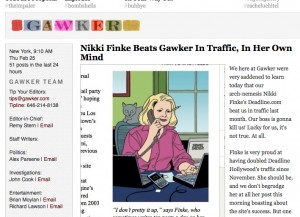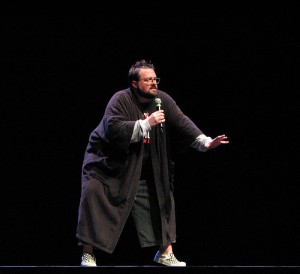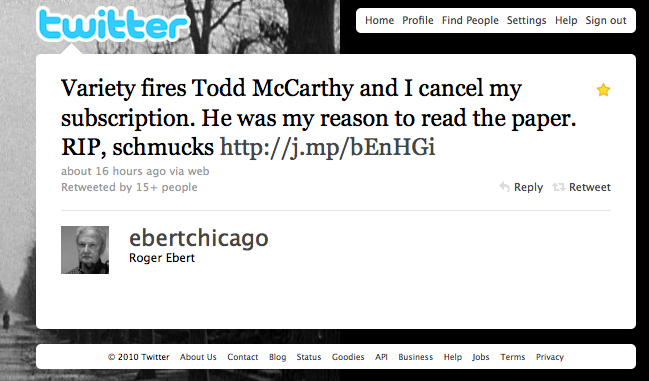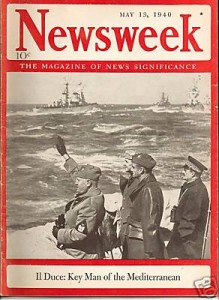Starting this week, the editor’s blog will feature an afternoon roundup of all things media from over the pond. From the hugely important to the very inconsequential, check in for a choice of America’s journalistic goings on.
Public feuding seems to be flavour of the week this week, with Cheryl and Ashley Cole fighting it out on the fronts of red tops and t-shirts, and Anna Ford and Martin Amis going pound for pound in the letter pages of the Guardian.
With no shortage of handbags stateside either, today’s digest seems, somewhat tenuously, to be all about what the media had to report on feuding.
Round One: Sally Quinn vs. those pesky gossipers
Washington Post columnist Sally Quinn, who writes a lifestyle column called “The Party”, used her most recent column to address claims amongst gossip columnists that two Quinn family weddings scheduled for the same day were evidence of some kind of family feud.
Unfortunately for Quinn, Washington Post executive editor Marcus Brauchli didn’t take very kindly to the article. More unfortunately for Quinn still, Washington City Post editor Erik Wemple (who, lucky, lucky man, appears in US Digest for a second day running) turned all his communicative efforts to getting some information out of the Post, and quite impressively got around the Brauchli very own eponymous omerta, the Brauchli Doctrine, to get the scoop on his reaction.
That reaction was to bring a swift end to “The Party”, like two surprised parents returning from holiday early. As tragic an event as the failure of the Cole’s marriage, Quinn’s column has been cut from the print edition of the post, Brauchli has banished it to the doldrums of Washington Post online.
And who the hell reads their journalism online?
Amidst a raft of “The Party Is Over” headlines, Gawker, ever moderate in their approach, ran with this gem instead:
Sally Quinn’s Stupid Idiot Column Being Killed, at Long Last?
But very kindly let up in their opening paragraph:
The Washington Post is reportedly considering doing away with Sally Quinn’s godawful self-absorbed rich lady column from hell, which is an embarrassment to the entire institution.
Continuing on with the feuding theme, both the Washington Post and Gawker have their own scraps featured in the press today.
Round Two: The Washington Post vs. New York Times
Michael Calderone from Politico reports on the Post and the NYT trying to pinch each other’s staff. The Times are apparently in the lead at the moment, having raided the Post newsroom consistently for the past few years, but the Post, with a couple of fresh vacancies on the Politics desk, are eyeing up staff at the Times.
Still, it seems that the Times, a full 26 years older than the Post, is keeping the upstart down.
Both papers have long sought out top journalists in Washington and elsewhere, but in recent years, The Times has been able to grab more talent from the Post than vice versa.
Gawker doesn’t seem to think America’s top journos are too well off at either paper right now:
What are those slick bastards at the Washington Post trying now? They are trying―and failing―to hire a bunch of good reporters away from the NYT […] And that looks even worse for the Washington Post, since all the New York Times can offer its own staffers now are fake sideways promotions, like, why don’t you go from editing this one thing, to writing about this other thing? Because there are no new jobs there, you see. But hey, at least it’s not the Washington Post!

The NYT - not to be poached from
As promised, news of Gawker’s very own new spat:
Round Three: Deadline Hollywood vs. Gawker
The Deadline Hollywood blog’s Nikki Finke claimed yesterday that she had bested Gawker’s stats for the month and, not only that folks, she had done so without having to “bottomfeed about celebrities just to increase web traffic”.
Well, in hindsight, that was probably a mistake. Actually it definitely was a mistake, and Gawker came out of their corner with irrefutable stats to prove it and, more importantly, another great sucker punch of a headline:
Nikki Finke Beats Gawker In Traffic, In Her Own Mind
Finke’s very begrudging correction can be found appended to her post, with a suitable shift of blame.

Gawker - not to be messed with
Enough of media feuding now? Me too. But it’s the theme of today’s post so, the show must go on. In the case of Keven Smith much-publicised set-to with SouthWest Airlines, the show goes on, and on, and on, and…. on.
Round Four: Kevin Smith vs. the media
Having been ejected from a SouthWest airlines flight just prior to take-off because staff were worried his weight was a safety issue, the film director Kevin Smith used his Twitter account, followed by 1,669,611 people, to launch a seemingly interminable campaign against the airline. Clever Southwest.
That bit is old news.
But in a new interview with Patrick Goldstein of the LA Times, Smith has dragged the media into the feud, claiming their reaction left a lot to be desired:
It really sickened me that after all the years I’ve been so open with the press that they didn’t bother to dig at all. I was unfairly bounced and discriminated against, but they never bothered to tell that story. They just went with the easy fat jokes. Every TV show imaginable asked me to go on, from Oprah to Larry King, but I turned them all down because I didn’t want to turn into Octomom.
So Kevin Smith is peeved with the media now too, but still kindly giving them material for their ‘easy fat jokes’ with talk of bouncing and the Octomom. Which, obviously, we are not going to exploit here at J.co.uk, because I’m no good at puns.

Kevin Smith - not too big to get on tiptoes
For more airplane related tales of less-than-respectable reporting, follow this link.
Having shamelessly cast aside everything really newsworthy in today’s digest in favour of stories that tenuously serve my feuding theme, I am running short on material. So, finally, and most tenuously of all, the social media story du jour, which sees Conan O’Brien amass way more followers with one tweet than Jesus fed with his five loaves.
Round Five: Conan O’Brien vs. Jay Leno
Conan O’Brien took over NBC’s Tonight Show from Jay Leno back in June 2009, but walked out on the show over a proposed scheduling change that would see it moved it from 11:35pm to 12:05am.
Retired, probably at a loose end, O’Brien did what any self-respecting man would do and joined Twitter, getting off to a pretty funny start:
Today I interviewed a squirrel in my backyard and then threw to commercial. Somebody help me.
O’Brien’s followers started to stack up at a mind-bending rate. At the time of writing he has 257,328, but by later this afternoon it could easily be 1040.
This fairly innocuous story soon grew into an infant media feud, with headlines uniformly reading something like this:
Conan O’Brien joins Twitter, outdoes Leno again.
Jay Leno’s followers, at the time of writing: a paltry 30,371.

Conan O'Brien - not too busy to tweet
Image of the New York Times building courtesy of ReservasdeCoches
Image of Kevin Smith courtesy of Shane Kaye
Image of Conan O’Brien courtesy of VDTA Info


















